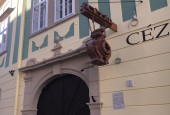The József Horváth of Sopron Collection (Caesar House)
The building on the corner of Hátsókapu Street was named after its last owner, the Caesar House, and its present character was shaped after the fire in Sopron in 1676. Nowadays, a memorial exhibition of the Munkácsy Prize-winning painter József Horváth of Sopron can be seen upstairs.
The building was the site of many significant events: in 1681 Count Pál Esterházy was elected palatine here. Károly Martonyi, the first Hungarian researcher of earth pressure theories, the founder of experimental soil mechanics, the inventor of the compressed air respirator and field kitchen, was born here. Between 1871 and 1881 the Sopron Upper Girls' School operated here.
Nowadays the József Horváth of Sopron Exhibition is housed upstairs. József Horváth, who was later honoured by the town and remembrance with the surname “Sopron”, was described as “the master of watercolour”, “the poet of watercolour”. He was not born in the town, but his life and work as an artist here made him a real Sopron citizen.
From 1910 to 1914 he studied at the Budapest College of Fine Arts, from 1914 to 1916 in Nagybánya, at the artists' colony. From 1920 he worked as an art teacher in Sopron. He became a genre-creating master of his chosen method of painting, watercolour. He made the expressive power of his paintings unrivalled by his unique method, in which, as we now know, he had no predecessor or follower. His work was awarded 21 times, with the most prestigious awards in Hungarian art life, including the Esterházy and Munkácsy awards. From his most beautiful watercolour paintings, his widow and his son Bertalan created an exhibition in 1961. The exhibition features not only his large-scale paintings, but also his charcoal drawings, including his 1954 Munkácsy Prize-winning painting ("What will happen to you").
The Horváth József Collection in Sopron can be visited by groups with prior registration at least 3 days before the planned date.


